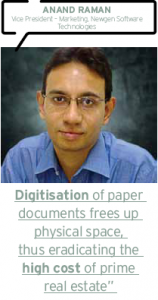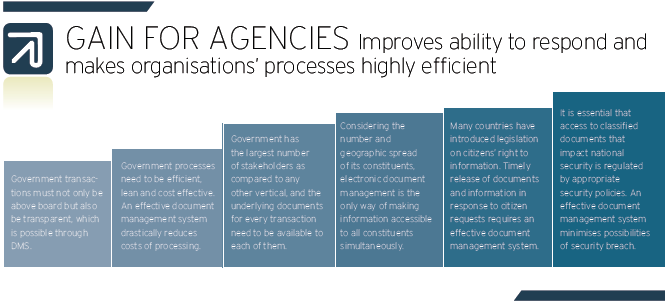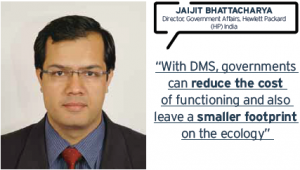DMS solutions drastically cut the documentation time and make availability of citizen services a matter of few clicks only
By Gayatri Maheshwary
DMS for all

-
Centralised storage system
-
Searchable documents and designs
-
Approval process to control document update/additions
-
Version controlling of documents
-
Online submission of document request
-
Reporting
In the recent years, transition to electronic management of documents has been very rapid. Concepts like digital asset management, document imaging, and workflow and records management systems have gained momentum.
Document management system (DMS) makes use of such concepts and it is fast emerging as an effective tool in facilitating e-Governance initiatives. One of the key objectives of DMS is to simplify the access and management of information in a cost-effective manner, while saving time and space.

With the technology driving government-to-government (G2G) and government-to-citizen (G2C) services in a big way, government departments and agencies have a plethora of digital asset to store, manage and retrieve for future reference. DMS comes handy for the purpose.
 The need for DMS can be gauged by the fact that unstructured data is growing at a rate of 65% and it will continue to grow at the similar rates in coming years, as per a study. According to IDC, the content management software market, which overlaps with the DMS market, will be worth $362 million by 2012 in the Asia Pacific region. Another estimate pegs the DMS market in India at $75 million in 2012, with at a CAGR of 13.2%.
The need for DMS can be gauged by the fact that unstructured data is growing at a rate of 65% and it will continue to grow at the similar rates in coming years, as per a study. According to IDC, the content management software market, which overlaps with the DMS market, will be worth $362 million by 2012 in the Asia Pacific region. Another estimate pegs the DMS market in India at $75 million in 2012, with at a CAGR of 13.2%.
Vipin Tuteja, Executive Director, Marketing and Business Support, Xerox India Limited, notes that DMS has a critical role to play in increasing productivity, improving citizen service and reducing the cost base. Whether digital or paper based, documents allow governments to store, retrieve and manage the most valuable asset–information. When properly managed, dissemination and re-use of that information is used to create value.
DMS can be software-centric or hardware-centric, and depending on the scale, operation and needs of the organisation, a particular solution may be favoured.
Anand Raman, Vice President—Marketing, Newgen Software Technologies, says a software-centric DMS with a five-year totalcost of ownership (TCO) onsideration should be the way forward for government department and agencies. The five-year TCO clause will take care of all technological redundancies and ensure that systems are always up to date.
DMS and e-Governance
DMS facilitates e-Governance with functionalities such as advanced file approval, management, tracking and intelligent search system. Experts are of the view that DMS will become the basic infrastructure on which all efficient and transparent G2C services will be running.“DMS will act as the ‘trusted system of records’ with controlled access to content in order to support regulatory compliance and continuity,” says Raman.
With more and more government services going online, in the last few years many state governments have initiated and implemented DMS projects. NewGen implemented e-Disha in Haryana to provide citizen-centric services aimed at reducing paper-based processes for the common man.
As more and more government services become online, e-records will be used to maintain data for various services like pensions and other entitlements, birth registrations and death records, and verification of citizenship and voting rights. It will also simplify collection of taxes and support financial management and audits, as also help resolve land claims and litigations. Further, it will facilitate intergovernmental agreements, economic planning, and other information-intensive activities.
In 2005, Department of Science & Technology, Government of Gujarat, initiated Integrated Workflow and Document Management System (IWDMS) to provide better services to citizens. IWDMS provisions for a central numbering system for all correspondence and files to make them traceable. The system helped eliminate several steps, right from a physical correspondence to creation of a file. The electronic drafts attached to files created in IWDMS can be edited at each level and also a track can be kept of the changes made at various levels. The system has also helped save time in transporting the physical files.
DMS and Healthcare
 The healthcare sector has a major challenge to seamlessly manage all patient records while ensuring improved efficiency, reduced costs and increased revenues at a relatively low investment in technology.
The healthcare sector has a major challenge to seamlessly manage all patient records while ensuring improved efficiency, reduced costs and increased revenues at a relatively low investment in technology.
Raman points out that the healthcare sector faces the challenge of processing large volumes of documents with strict turnaround times (TATs) and service level agreements (SLAs). The processes are paper intensive and are regulated by regulatory and compliance requirements like Health Insurance Portability and Accountability Act (HIPAA) in the US. DMS solutions help healthcare centres in providing views of entire medical histories and faster access to specialist correspondence, among various other benefits.
DMS and Education
The need for digitising information and various other academic resources is being felt in the education sector. Bhattacharya says, “It is easier to adopt DMS in education as the stakeholders are more flexible and have a higher potential to learn new tools faster.” For example, libraries can select DMS solutions to manage the digitisation of historical records and build a digital library.
“DMS in education is yet to happen in a structured manner. Currently, ad-hoc solutions are being used to take care of specific needs. Education being cost-sensitive with regards to IT, the best way forward would be to go for software as a service (SaaS) model, with some specific solutions built on the DMS platform,” Raman opines.

Returns on DMS investment
Many of those using DMS are of the opinion that RoI on it is quite quick. Anindya Banerjee, Independent Consultant, reasons that RoI considerations in the government are not required as the file restoration itself will clear a lot of unnecessary load from government offices.
Talking of the RoI benefits that DMS offers, Raman says, “Digitisation enables departments to convert documents into digital formats and send a good percentage of paper documents to remote record management facilities, thus freeing up physical space in the department. This eradicates the high cost of real estate at premium office locations.”
The potential beneficiaries
Over the years, the adoption of DMS has grown and certain government bodies have adopted it as a core process. Governments organisations that have not yet leveraged DMS will soon be looking at it as a potential process and citizen service enabler. The trend is seen to be growing at a considerable pace in the coming years. The huge volume of information stored on physical files has to be digitised and this has opened up huge opportunities for various DMS providers.
 According to IDC research findings, companies with the fastest growing profits in their industry sectors are tackling documentation processes and achieving real benefits. Specifi- cally, a positive relationship has been noticed between effective document management and average profit growth and an organisation’s ability to respond to changing market conditions.
According to IDC research findings, companies with the fastest growing profits in their industry sectors are tackling documentation processes and achieving real benefits. Specifi- cally, a positive relationship has been noticed between effective document management and average profit growth and an organisation’s ability to respond to changing market conditions.
It is expected that benefits of DMS will be extended in the government sector as well. On the potential beneficiaries for DMS, Bhattacharya feels that various government departments, PSUs and even municipal bodies have a high potential of leveraging DMS to become more effective and responsive to citizen needs. DMS fundamentally changes the ability of an organisation to respond to external requests and makes the organisation highly efficient from a process perspective.
Several counties in US states have implemented DMS as per their requirements. For instance, the Orange County In the state of California is using a document management system that enables sharing and reuse of documents by multiple agencies in the county. This streamlines and greatly simplifies the documentation process. Closer home, an e-Governance application developed by TCS for the Government of Kerala incorporates document capture, OCR and full-text search capability. The solution provides significant benefits by doing away with much of the manual processes involving documents.
Less-paper departments
However, DMS implementations in the government sector are more widespread in the US, which is yet to become much of a trend in India. With the growing realisation that government departments need to be more proactive in meeting citizen requirements, there has been a concerted effort in improving service levels. Consequently, there has been a rapid increase in households that use, say, utilities like water and electricity. All this has blown up the generation of paper-based documents to the extent of unmanageability, since robust document and record management systems are not yet in place.
“With the expansion happening, the use of paper-based documents is soaring up. DMS should be robust and scalable so that it can support expansion. For faster rollouts, there is a need for establishing shared service centres (SSCs) which work as centralised repositories. Centralised document repositories, with rights-based user access, are becoming the obvious solution in view of the increasing volume of work and paper documents,” comments Raman.
“Besides, with more environment consciousness around, there is a move towards reducing the amount of paper significantly. Though there can never be paperless departments, governments can still have ‘less paper’ departments,” says Tuteja.
The Road Ahead
Rising data volumes, along with regulatory issues and the need for faster decision making and contingency planning are some of the factors driving the adoption of DMS. Government agencies will also need to start investing in DMS with an eye on automation.
Other aspects driving the DMS market are virtualisation and integration. Also, the need to share information and documents with dispersed entities and improve collaboration and effectiveness of various functions will add to the benefits. The need for DMS lies in its ability to handle documents and manage huge chunks of information.
Today, governments are also faced with budgetary constraints. DMS will help reduce cost and bring in higher efficiencies. Digital management of records and data has gained momentum in the recent times as the need and the importance to secure every piece of information has strongly been realised.
Bhattacharya says, “DMS will become a regular part of governments’ documentation process. It will be very difficult to be able to function effectively without adoption of DMS. DMS tools will have the same level of adoptionas other standard IT applications.”
There is a need for the implementation of statutory requirements in India, and once done, there will be a huge demand of DMS. It will help maintain the records while also ensuring the information security requirements. The ongoing adoption of document management system by a few governments and departments will be acting as a catalyst for other government agencies as well.
Be a part of Elets Collaborative Initiatives. Join Us for Upcoming Events and explore business opportunities. Like us on Facebook , connect with us on LinkedIn and follow us on Twitter, Instagram.











